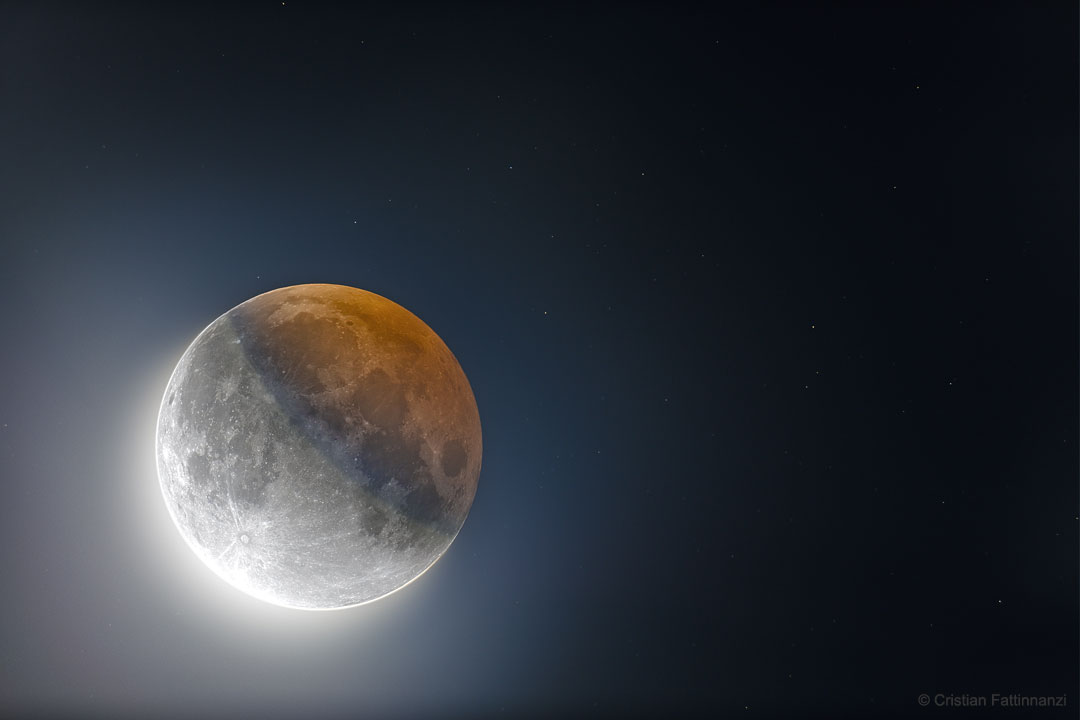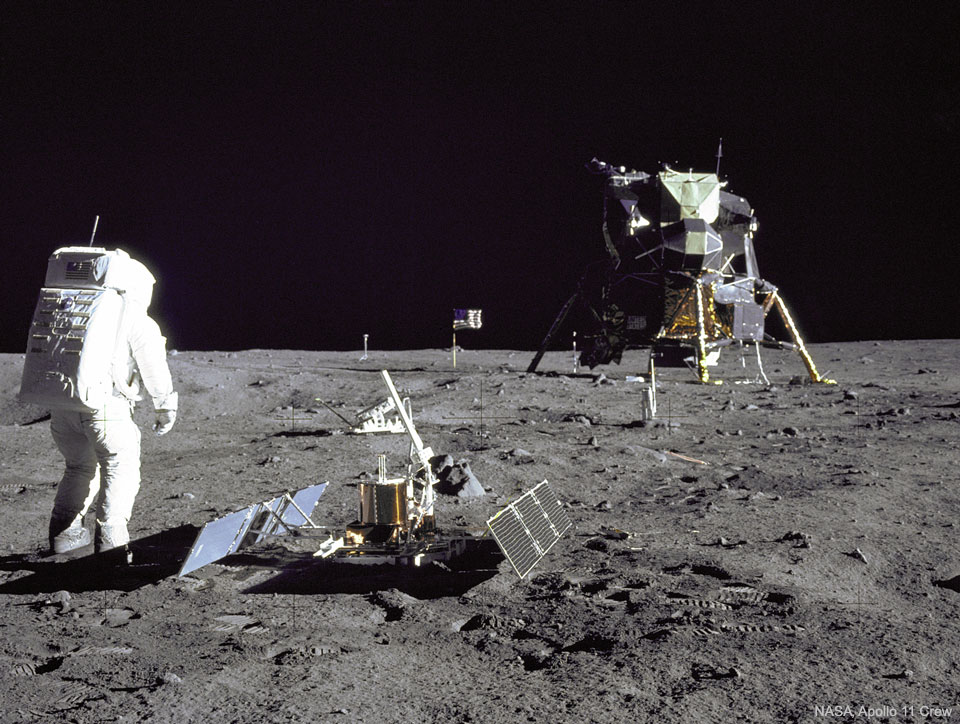2019年7月31日 星期三
This Week in NASA History: First Use of the Lunar Roving Vehicle – July 31, 1971

ISS Daily Summary Report – 7/30/2019
July 31, 2019 at 12:00AM
from NASA https://ift.tt/2OvHH8A
via IFTTT
2019年7月30日 星期二
Bridenstine At ISSRDC On Wednesday
ISS Research and Development Conference livestream
8:30 - 9:00 AM Morning Keynote with NASA Administrator Jim Bridenstine
"On Wednesday, July 31, during the 8th annual International Space Station Research and Development Conference (ISSRDC), NASA Administrator Jim Bridenstine and International Space Station U.S. National Laboratory Chief Executive Officer Dr. Joseph Vockley will hold a press conference to discuss the critical importance of our nation's only orbiting laboratory."
Keith'snote: Offsite media questions will be submitted via Facebook and Twitter screened by CASIS. Since CASIS refuses to accredit NASAWatch as news media it is unlikely that I will be allowed to ask a question.
from NASA Watch https://ift.tt/2YvEup2
via IFTTT
ISS Daily Summary Report – 7/29/2019
July 30, 2019 at 12:00AM
from NASA https://ift.tt/2Zlooj8
via IFTTT
2019年7月29日 星期一
What Is CASIS Up To?
We've received reports of clandestine, offsite meetings on Monday between @NASA ISS Director Sam Scimemi and @ISS_CASIS CEO Joe Vockely. Hmm ... what will be announced in the press conference with @JimBridenstine on Wednesday? #ISSRDC #askISSRDC pic.twitter.com/b0QaPB3F5z
— NASA Watch (@NASAWatch) July 30, 2019
from NASA Watch https://ift.tt/2MoE4hN
via IFTTT
What Ever Happened To That Orbit Beyond Moon Mission?
Bengaluru firm to build moon lander for Nasa 2020 mission, Times of India
"Confirming the development, Team Indus engineer Ananth Ramesh told TOI: "Yes, we will be building the lander. It is most likely to be built in India too." Team Indus CEO Rahul Narayan was in the US to sign the contract documents on Thursday."
America's first private moon lander will be engineered in India, Quartz
"Orbit Beyond, which will assemble the lander and spacecraft in Florida, also includes US firms Honeybee Robotics, Advanced Space, Ceres Robotics, and Apollo Fusion to handle tasks including the installation of scientific payloads, maneuvering from the earth to the moon, and operations on the lunar surface."
Keith's 15 June note: If you read articles about OrbitBeyond in the Indian press they all say that the lander will likely be built in India. If you read stories published in the U.S. they say it will be assembled here. This issue apparently came up in last week's space science hearings. OrbitBeyond is a privately held company that was only recently established and looks to be designed as more of a shell company to coordinate the activities of its various team members. The bulk of the hardware is going to be of Indian design. The lingering question is: where will it actually be built?
Keith's 29 July note: OrbitBeyond has not replied to multiple requests on this issue sent more than a month ago. Various sources point to mounting management problems within OrbitBeyond. In a nutshell NASA picked Team Indus, an Indian company that was trying to win he Google Lunar X Prize to build this mission. That is becoming apparent to people involved in Orbit Beyond now. Stay tuned.
from NASA Watch https://ift.tt/2ZuhNTm
via IFTTT
About That NASA Moon/Mars Thing
My Open Letter to NASA Managers Who Can't Say "Moon" without "Mars" in the Same Sentence: Please stop it., Homer Hickam
"We've even got a Vice President who is behind NASA, who wants you to go to the moon and build something permanent there, and who has stuck out his neck for you. For years, lots of us have been working in every way we can - me with my books and my other writings - to get someone in the Executive Branch who is really serious about going back to the moon, not in a sprint with flags and all that but for a purpose that's good enough to keep us there.
But now I fear you're about to totally screw it up mainly because of where your heads are on this moon and Mars thing.
So, with great respect to all of you who toil every day on the pathways to space, let me be clear: Every time you folks at NASA tack "and then we're headed to Mars" onto your comments about going back to the moon, you diminish the moon as a destination whether you realize it or not. As such, you are totally confusing everybody, especially young people. Common sense says you're not going to Mars because you have no orders to go there and the technology not only doesn't exist, there are no plans to make it exist.
So, dear NASA folks, if we're going to get young people excited about space, trust me on this: The moon is exciting enough and I'm going to tell you why."
from NASA Watch https://ift.tt/32YJFBy
via IFTTT
DRAGON ARRIVES AT THE INTERNATIONAL SPACE STATION
Dragon arrived at the International Space Station on July 27, 2019 and was captured at 6:11 a.m. PDT while flying about 267 statute miles over the coast of southern Chile. The spacecraft was then installed on the Harmony module for the duration of its four-week stay at the orbiting laboratory.
Filled with approximately 5,000 pounds of supplies and payloads, Dragon launched aboard a Falcon 9 rocket on July 25, 2019 from Cape Canaveral Air Force Station in Florida. The Dragon spacecraft supporting the CRS-18 mission previously supported the CRS-6 mission in April 2015 and the CRS-13 mission in December 2017. Dragon is the only spacecraft currently flying that's capable of returning significant amounts of cargo to Earth. 
from SpaceX News https://ift.tt/2ymAhJW
via IFTTT
ISS Daily Summary Report – 7/28/2019
July 29, 2019 at 12:00AM
from NASA https://ift.tt/2ZdFOy5
via IFTTT
NASA Pilot Rich Rogers: "All Good Things ..."

The NASA-sponsored Space Station Conference That NASA Is Not Talking About
Keith's note: The CASIS-sponsored International Space Station Research And Development Conference is underway in Atlanta. NASA Administrator Jim Bridenstine is speaking at ISSRDC on Wednesday. NASA has not issued any media advisories about Bridenstine's appearance or the conference in general but CASIS did last week.
You'd think that NASA would want people to know that this event is going on. Guess again. If you go to @Space_Station with its 2.7 million followers there has been no mention whatsoever. Nor has there been any mention by @NASA with its 32 million followers. No mention at NASA.gov, or at NASA TV, or at the NASA HQ ISS page.
A few weeks ago NASA went up to New York and did a big thing on Wall Street to promote NASA's plans to open up the ISS to more commercial uses. CASIS was invisible at that event and is not mentioned in any of NASA's new ISS commerce plans. Now NASA is going out of its way to dial back promotion of this ISSRDC event - even though there is a NASA logo all over everything.
If NASA was actually interested in the commercial potential of the ISS then you'd think that they'd use every opportunity to promote the potential of the ISS. But they don't. Why?
from NASA Watch https://ift.tt/2GwxW3d
via IFTTT
2019年7月28日 星期日
NASA Asked CASIS To Stop Paying Its Board Of Directors
Keith's note: In a 7 March 2019 letter from NASA Space Station Director Sam Scimemi to CASIS CEO Joseph Vockley, Scimemi states that NASA believes that "the CASIS Board of Directors size and scope should be reduced. In addition to the subject if the Board's compensation addressed in CASIS Cooperative Agreement Modification 14, we recommend reducing the number and composition of the directors per the enclosed proposed revisions to your bylaws. We also believe that based on CASIS's performance sinece the NASA letter, dated November 16, 2017, that the ad hoc advisory committees created by the Board, including operations, business development, science and technology, and STEM education, are no longer required. The Board should retrun to a governing manner of corporate management and oversight in order to comply with the CASIS bylaws."
"Recommended Changes to CASIS, Inc. Bylaws
3.02 (2) The Board shall consist of not fewer than five (5) and not more than nine (9) managing directors with at least fifty percent of the exact number to be scientific of which shall be determined from time to time by the board.
3.10 Compensation of Directors. Directors may be reimbursed for expenses incurred in the performance of their duties to the Corporation in reasonable amounts but will not receive compensation for their service on the Board."
On 10 April 2019 Vockely signed off on a cooperative agreement modification which says that "The CASIS Board of Directors will not be compensated for their time in participating as a Board member (Travel expenses will be paid). This is consistent with best practices for non-profit Boards of Directors".
Hmm ... this change in policy states that not paying board members for their time "is consistent with best practices for non-profit Boards of Directors". If so then why did CASIS pay their board members in the first place? Where they not in compliance with best practices for non-profit Boards of Directors? NASA highlighted issues with the CASIS board in a 16 November 2017 letter. CASIS replied to NASA about the issues raised by NASA on 22 January 2018. Apparently CASIS did not move on these issues thus requiring NASA to send another letter on 7 March 2019.
If you look at the most recent CASIS 990 form filed with the IRS for 2017 Part VII (pages 7 and 8) "Compensation of Officers, Directors,Trustees, Key Employees, Highest Compensated Employees, and Independent Contractors" you will see what the CASIS board members are paid an average fo $40,000 a year and senior members of CASIS staff are paid from $200,000 to over $300,000.
11 CASIS board members are listed in the latest 990 form. With one exception the board members were paid between $38,000 and $41,000 a year for 8.00 hours a week of work. For the sake of analysis, let's assume an average of $40,000 a year for those 10 people serving on the CASIS board. If you assume a 52 week year that's 416 hours per year or $96/hr. If you assume a 2,080 hour annual work year that rate is equal to an annual salary of $200,000.
In an earlier story from 2015 "Examining Staff and Board Member Salaries at CASIS" I noted that the 2013 990 form showed that CASIS board members were paid an average of $49,750 a year for 6.00 hours of work a week or $159.45 an hour. This hourly rate is what someone with a salary of $330,000 earns. So ... CASIS board members took a big pay cut. But they were still being paid as of the last IRS filing.
The current board listed by CASIS shows 9 board members - the maximum number that NASA requested. Given that the 990 form filed by CASIS claims that these board members work 8 hours a week (i.e. one work day) is significant. That means they devote 20% of a standard work week - every week - to CASIS. Exactly what that work is or how it is confirmed as having been accomplished is not mentioned by CASIS. I have been on the board of directors of two space-related non-profit organizations (no compensation whatsoever) so I have an idea what is involved in board responsibilities and why people serve on boards. At this level of payment and work CASIS board members were contributing significant labor to CASIS more akin to what a consultant would offer - beyond what you might expect a board member to be offering. That point is now moot since the board members are doing it for free - assuming that CASIS has complied with NASA's request, that is. Of course there is also the question of whether the board's responsibilities have changed now that they are not being paid - or if they are still working one day a week for CASIS. I'd ask - but CASIS does not respond to any NASAWatch inquiries.
But wait: there is a press event with Jim Bridenstine and Joe Vockley on Wednesday at the ISSRDC event. Alas, offsite media can only use social media to suggest questions.
- 17 November 2017 Letter from NASA to CASIS Regarding Complaints About CASIS Activities
- 22 January 2018 Letter from CASIS To NASA Regarding Complaints About CASIS Activities
- Earlier posts about CASIS
from NASA Watch https://ift.tt/2ylOPcI
via IFTTT
2019年7月27日 星期六
This SNL Sketch Where Victoria Jackson Dances on Dennis Miller’s Desk Is an Elegiac Tribute to a Time Before Baby Boomers Ruined the World

Let me begin by saying that the thirtysomething generation, of which I am a member, is the most anxiety-ridden, emotionally unstable generation in our history. In a recent issue of the Sunday New York Times, I read a very frightening statistic: that my fellow Baby Boomers are so chronically depressed, we are more prone to suicide, divorce, drug and alcohol addiction because of outside pressures and goals we have set up for ourselves which are highly unrealistic!
That’s why we’re all in therapy or low-impact aerobics,
Or reaching out to anything that’s new.
But I have found a way to keep anxiety at bay,
And I would like to share now with you!
I read the news in the press, most of us will die of stress,
Unless we dance ol’ chronic depression away!
We want power and control, that’s a really unhealthy goal!
It’s time to dance ol’ chronic depression away!
If your back’s against the wall and your career is in a stall,
Don’t jump out the office window!
’Cause the sidewalk will break your fall!
Shake the blahs, take a chance,
Roll up the carpet and move the plants!
Dance, dance, dance depression away!
TAP SOLO
If you want to shake the blues, just turn off the evening news!
Turn off the lights! Turn on the music! And [unintelligible]
And you’ll stop feeling paranoid, you don’t have to be Sigmund Freud,
Dance ol’ Mr. Chronic Depression—
Call the shrink and cancel the session!—
Dance ol’ Mr. Chronic Depression away!
from Slate Magazine https://ift.tt/2KaEdTc
via IFTTT
2019年7月26日 星期五
Starhopper Made Some Noise Last Night
Drone cam pic.twitter.com/gVdMrMgUZq
— e^👁🥧 (@elonmusk) July 26, 2019
Elon Musk says SpaceX could land on the moon in 2 years, Business Insider
"We recently asked Jeff DeWit, NASA's chief financial officer, about Musk's statements for an upcoming episode of "Business Insider Today," a top daily news show on Facebook. DeWit, who's in charge of helping the agency make the most cost-effective decisions, said he thought that the odds of SpaceX pulling off a private lunar landing with Starship before NASA can return there "are slim," but he did not rule out the possibility of a NASA-SpaceX partnership on a moon mission. In fact, he underscored the possibility. "More power to him. I hope he does it," DeWit said of Musk. "If he can do it, we'll partner with them, and we'll get there faster." He added: "This isn't about us doing it -- it's about America doing it. He's [got] an American company. I'd love to partner with him and get that done." SpaceX did not immediately respond to a request for comment about DeWit's statements."
from NASA Watch https://ift.tt/2Y9yF5m
via IFTTT
ISS Daily Summary Report – 7/25/2019
July 26, 2019 at 12:00AM
from NASA https://ift.tt/30QB6Xw
via IFTTT
Hubble Snaps a Galactic Potpourri of Particles

SpaceX Dragon en Route to Space Station with NASA Science, Cargo
July 25, 2019
from NASA https://ift.tt/313DxWR
via IFTTT
Joe Biden Is Punching Back Without Hitting Himself

4. Cory Booker
Does he have the guts to punch an elderly man?In an interview with Seth Meyers on Monday, New Jersey Sen. Cory Booker revealed that occasionally he is inclined to punch Donald Trump. “My testosterone sometimes makes me want to feel like punching him,” Booker said, “which would be bad for this elderly, out-of-shape man that he is if I did that, this physically weak specimen.” To be fair to Booker—IF WE MUST—he did say this as an introduction to his larger point, that giving in to violent, hateful thoughts would be bringing oneself down to Trump’s level. If, however, Booker does feel like acting on this impulse to punch an elderly man, he will have an opportunity to do so in Detroit, where he’ll be on the debate stage with Biden. The two have been at it again this week, with Booker calling Biden the “architect” of mass incarceration, and Biden responding that the Obama Justice Department released a report finding abuses within Newark’s police department, over which Booker presided as mayor. This could all explode onstage the second debate night; first-nighter Marianne Williamson won’t even be there to lighten the mood with a challenge to New Zealand.
from Slate Magazine https://ift.tt/2GvF3sN
via IFTTT
2019年7月25日 星期四
Seeing the World With a Drone

ISS Daily Summary Report – 7/24/2019
July 25, 2019 at 12:00AM
from NASA https://ift.tt/2Z88t7O
via IFTTT
2019年7月24日 星期三
Starhopper Did Not Hop
Well it didn't work (this time) but it would make for a pretty solid Mad Max sequel pic.twitter.com/ZML6UtgTqn
— Bobak Ferdowsi (@tweetsoutloud) July 25, 2019from NASA Watch https://ift.tt/30TO4nc
via IFTTT
Bridenstine Hits The Ground Running On Gateway
"NASA's decision, based on review of each NextSTEP-2 contractor's capabilities, to sole source the procurement of the MHM flight unit for the cislunar Gateway to Northrop Grumman Innovation Systems (NGIS) as a follow-on to the originally competitively awarded NextSTEP-2 BAA Appendix A, Habitat Systems studies, Contract NNH15CN76C (See below). ... In order to support the mandate to enable a human landing capability in 2024, the MHM must be launched in late 2023 to be delivered to Gateway no later than early 2024. The schedule constraints established by a December 2023 launch dictate that a module be on dock at Kennedy Space Center in mid-2023 for launch processing and integration. Per NASA's schedule analysis, this typical timeline for module production must already be compressed in order to achieve the 2024 human lunar landing deadline. Given that the NextSTEP-2 contractors advanced designs to a near System Design Review (SDR) fidelity, NASA determined that it must utilize the existing concepts from the NextSTEP-2 Appendix A and use the development done to date to minimize the additional design work necessary to produce a module in time."
Keith's note: NASA has been directed by Vice President Pence to truncate NASA's original plans to land people on the Moon in 2028 to a new date of 2024. That means NASA is going to have to make a number of prompt decisions on some basic aspects of how it accomplishes this 2024 goal. This NASA document makes mention of the fact that NASA is having to compress its procedures in order to meet the deadline set by Vice President Pence. NASA has decided that the only viable solution for a habitation module for the Gateway is to utilize a modified version of Northrop Grumman's Cygnus cargo spacecraft. This spacecraft (originally developed by Orbital Sciences which was bought by Northrop Grumman) has performed flawlessly each time it has flown, so it is a known, proven design. While it would not be surprising that other companies will protest this sole source decision by NASA, it is hard to argue that other companies could have been able to provide hardware on the dock at KSC when NASA needs it to be there.
The only thing that is missing from this document is the cost of this module which is redacted on page 5 of the original notice posted by NASA. Given the mysterious and ever-changing estimates of how much it will take NASA to meet the 2024 goal it is hard to imagine that this number will remain a secret. Indeed, just last week NASA Administrator Bridenstine openly admitted in congressional testimony that NASA has a chronic problem when it comes to estimating costs and then delivering on them.
Meeting the 2024 lunar landing date is going to be sporty - at a minimum. To his credit Jim Bridenstine has hit the ground running. Gateway has been downsized to a basic initial configuration. Maxar has the propulsion portion of the Gateway and Northrop Grumman now has the initial habitation portion. Orion and its service module exists and SLS is being fabricated albeit behind schedule. Moreover commercial launchers from SpaceX and ULA are ready for procurement to launch components. All that seems to be missing now is a lunar lander. NASA has a long way to go. Many people think that the landing could be done in a simpler fashion. But again, given the lead time Bridenstine has been given he has certainly risen to the challenge. It will be interesting to see who is picked to run HEOMD given that Bridenstine has said that some important decisions are on hold pending those appointments.
from NASA Watch https://ift.tt/2JYtN9u
via IFTTT
50 Years Ago Today: Apollo 11 Command Module Recovered After Splashdown

2019年7月23日 星期二
ISS Daily Summary Report – 7/22/2019
July 23, 2019 at 12:00AM
from NASA https://ift.tt/2M93r76
via IFTTT
The Internet Loves the Exclamation Point!!

Listen to Lexicon Valley:
Get More Lexicon Valley
Slate Plus members get extended, ad-free versions of our podcasts—and much more. Sign up today and try it free for two weeks.
Subscribe to Lexicon Valley
Copy this link and add it in your podcast app.
For detailed instructions, see our Slate Plus podcasts page.
Linguist and author Gretchen McCulloch joins John McWhorter to discuss her new book, Because Internet: Understanding the New Rules of Language, which explores the impact of social platforms on our linguistic conventions.
You’ll find every Lexicon Valley episode at slate.com/lexiconvalley.
Send your thoughts about the show to lexiconvalley@slate.com.
from Slate Magazine https://ift.tt/2M6sveZ
via IFTTT
Some Good News For NASA's $1.6 Billion Artemis Request
'Near-final' budget deal could prevent government shutdown, stabilize military funding, Defense News
"The retreat from the possibility of a one-year continuing resolution, which lawmakers and the administration had openly discussed, is a win for the Pentagon. While short-term stopgap CRs are nothing new, CRs do lock in spending at the previous year's level and bar new programs from starting as well as production increases."
Question: There is talk of not getting budget numbers and moving to a CR. That would be counter productive for you, correct? @JimBridenstine - "Yes, that would be devastating. If we end up in a CR the lander will not be developed". #Artemis #Moon2024
— NASA Watch (@NASAWatch) July 17, 2019
from NASA Watch https://ift.tt/2Of1LMi
via IFTTT
Christopher Kraft at Flight Console

They Came From Planet Claire

Listen to this episode of Studio 360 by clicking the arrow on the audio player below:
Get More Studio 360
Slate Plus members get extended, ad-free versions of our podcasts—and much more. Sign up today and try it free for two weeks.
Subscribe to Studio 360
Copy this link and add it in your podcast app.
For detailed instructions, see our Slate Plus podcasts page.
The B-52s went out of bounds on their danceable debut album.
Here’s another edition of This Woman’s Work, a series of stories from Classic Album Sundays and Studio 360 where we highlight classic albums by female musicians, women who continue to influence the world of pop culture and inspire others.
This time, we’re looking at the debut album of a band that seems to have landed here from some groovy planet. Four decades ago, the B-52s arrived on the Athens, Georgia, party scene with killer guitar riffs, their silly but eerie lyrics, and their sky-high beehive wigs.
Back in the late ’70s, after jamming on new songs in between stints at their various day jobs, the band debuted their first handful of tunes—and their unique look—at a friend’s house party. B-52s singer and keyboardist Kate Pierson remembers finding fur purses in an Athens shop. “They were fun fur, but we made them into white afros and we wore them on our heads. We wore black, and we had Barbie dolls hanging from the ceiling. It was a very punk scene. And when people danced, the house shook. People had to hold the equipment onto the shelves because the whole place was literally rocking.”
From that moment, the B-52s would go on to become the best party band on the planet. They were inspired by 1960s kitsch and sci-fi, but the music had a lean, danceable edge. Pierson says, “That was sort of our trademark. It was sparse and airy and punk.” The two women in the band, Pierson and Cindy Wilson, created some of the group’s more surreal and beautiful vocal moments, while also co-writing the songs and playing keyboard, guitar, and percussion.
Jake Shears, founder of the disco-rock group Scissor Sisters, became a B-52s superfan after hearing their music in fourth grade. “I would just have fantasies about having lunch with them, maybe if I wrote them a letter they would take me to dinner. I would cut out pictures of Cindy and Kate and then frame them and put them up on my desk.”
Shears’ obsession turned into inspiration when he formed his own group in New York years later. “I modeled Scissor Sisters off the B-52s. We were both bands that came from just sort of enjoying our life and wanting to put on shows to entertain our friends, just to have a good time.”
In this episode of This Woman’s Work, we’ll look back on the B-52s’ self-titled first album, which was released 40 years ago this month in 1979.
This podcast was produced by Colleen “Cosmo” Murphy and Studio 360’s Jocelyn Gonzales.
Studio 360 plugs:
Please remember to like our Facebook page and follow us on Twitter. Send your emails to incoming@studio360.org.
from Slate Magazine https://ift.tt/2Y9YWf5
via IFTTT
2019年7月22日 星期一
Eagle Scouts to Speak with NASA Astronaut Aboard Space Station
July 22, 2019
from NASA https://ift.tt/32HpOGL
via IFTTT
Visions of Apollo 11: Command Service Module Orbits the Moon

Mike Collins Prefers Mars Over The Moon
2009 Michael Collins Interviews Michael Collins UPDATED for the 50th Anniversary July 2019
"Q. Okay but getting back to the space program. What's next?
A. I hope Mars. It was my favorite planet as a kid and still is. As celestial bodies go, the moon is not a particularly interesting place, but Mars is. It is the closest thing to a sister planet that we have found so far. I worry that at NASA's creeping pace, with the emphasis on returning to the moon, Mars may be receding into the distance. I would advocate for a "JFK Express to Mars". President Kennedy's 1961 mandate to land man on the moon within the decade was a masterpiece of simplicity and we invoked it often to get the job done."
from NASA Watch https://ift.tt/2O9voyv
via IFTTT
The Border Patrol’s Secretive Culture

Listen to What Next:
Get More What Next
Slate Plus members get extended, ad-free versions of our podcasts—and much more. Sign up today and try it free for two weeks.
Subscribe to What Next
Copy this link and add it in your podcast app.
For detailed instructions, see our Slate Plus podcasts page.
“I’m 10–15.” That’s the Border Patrol code for “alien in custody.” It is also the name of a secret Facebook group where a number of Customs and Border Protection agents posted racist and sexist memes. What about this agency allows such rampant misconduct?
Guest: A.C. Thompson, reporter at ProPublica. Read his story on the secret Border Patrol Facebook group.
.Podcast production by Mary Wilson, Jayson De Leon, and Ethan Brooks.
from Slate Magazine https://ift.tt/2OaGinK
via IFTTT
2019年7月21日 星期日
HDR: Earths Circular Shadow on the Moon

What’s It Like to Be a Firefighter?

Get More Working
Slate Plus members get extended, ad-free versions of our podcasts—and much more. Sign up today and try it free for two weeks.
Subscribe to Working
Copy this link and add it in your podcast app.
For detailed instructions, see our Slate Plus podcasts page.
Listen to Working via Apple Podcasts, Overcast, Spotify, Stitcher, or Google Play.
Ever since his first season as the host of Working, Jordan has wanted to interview a firefighter. It’s a job everyone knows about. But the day-to-day of a firefighter’s work might not be so familiar. Jordan sat down with Jason Powell, a firefighter with Engine Company 69 in Harlem, New York, about his four years on the job and all the training, danger, and cooking that goes into it.
You can email us at working@slate.com.
Podcast production by Jessamine Molli.
from Slate Magazine https://ift.tt/2JHb3MA
via IFTTT
Those Times The President Said The Moon/Mars Phrase
20 Jul 1989 George H.W. Bush told @NASA return to the Moon then go to Mars.
— NASA Watch (@NASAWatch) July 21, 2019
14 Jan 2004 George W. Bush: same thing.
18 June 2018. Trump: same thing.
I was standing a few feet away each time. Why am I thinking of Lucy and the football?#Apollo50 #Artemis #Moon2024 pic.twitter.com/GhM75Eeoo2
from NASA Watch https://ift.tt/30KCfQi
via IFTTT
2019年7月20日 星期六
Moonquakes Surprisingly Common

VP Pence At KSC: Bipartisan Support Without Bipartisan Attendance
"And while we've made great strides in advancing the President's bold vision for space -- unlike in years past, we will have the budgets to match it. And that's why I'm especially grateful today to be joined by some of the greatest champions of American leadership in space in the Congress of the United States: House Minority Whip Steve Scalise, Congressman Robert Aderholt, Congressman Brian Babin, Congressman Bill Posey, and other distinguished members of Congress. Would you please rise and allow us to express our appreciation for your strong support of renewed American leadership? (Applause.)"
Today at the @VP Pence event at @NASAKennedy there was mention of "bipartisan support" for #Artemis and the #Moon2024 goal. by @JimBridenstine But the only politicians introduced were republicans. Where were the democrats? Were they invited? #apollo50
— NASA Watch (@NASAWatch) July 20, 2019
from NASA Watch https://ift.tt/2XWkEb5
via IFTTT
The Words VP Pence Said About Apollo 11

"Apollo 11 is the only event in the 20th century that stands a chance of being widely remembered in the 30th century. A thousand years from now, July 20, 1969 will likely be a date that will live in the minds and imaginations of men and women, as long as there are men and women to remember -- across this world, across this solar system, and beyond."
from NASA Watch https://ift.tt/2JXgIwP
via IFTTT
NASA Astronaut Andrew Morgan, Crewmates Arrive at Space Station on 50th Anniversary of Moon Landing
July 20, 2019
from NASA https://ift.tt/32HFY2G
via IFTTT
NASA Updates Broadcast of Next Space Station Resupply Launch, Prelaunch Activities
July 20, 2019
from NASA https://ift.tt/2JJccn3
via IFTTT
Vice President Unveils NASA Spacecraft for Artemis 1 Lunar Mission on Moon Landing Anniversary
July 20, 2019
from NASA https://ift.tt/2YjDOa8
via IFTTT
Bringing Beauty And Glamour Back To NASA For Centuries To Come
Remarks by President Trump Commemorating the 50th Anniversary of the Apollo 11 Moon Landing
"THE PRESIDENT: And we opened up our fields. When we took it over, they were all covered with grass, and they were broken and they were in bad shape. And NASA -- if you look at Kennedy, if you look down in Florida, you look -- wherever you want to look, it was not a pretty picture. They were almost, you could say, abandoned, and now they're in tip-top shape."
"THE PRESIDENT: And, you know, one of the things: We're bringing the glamour back to it because it lost the glamour. It lost everything. If you would have seen these fields when we took over -- really, you started about a year, year and a half ago. When we took over, it was unbelievable. It looked like an abandoned town. And now there's beauty. There's beauty, and there's a lot of things happening. A lot of really great things are happening. So we're very proud of that."
Presidential Message on Space Exploration Day, 2019
"To honor those who have come before us and for the future betterment of all humankind, we pledge to launch a new era of exploration, extending our pioneering spirit into the farthest reaches of the cosmos. My Administration is committed to reestablishing our Nation's dominance and leadership in space for centuries to come."
from NASA Watch https://ift.tt/2O5CeVH
via IFTTT
Legends and Myths of the Supreme Court

To listen to this episode of Amicus, use the player below:
Get More Amicus
Slate Plus members get extended, ad-free versions of our podcasts—and much more. Sign up today and try it free for two weeks.
Subscribe to Amicus
Copy this link and add it in your podcast app.
For detailed instructions, see our Slate Plus podcasts page.
Listen to Amicus via Apple Podcasts, Overcast, Spotify, Stitcher, or Google Podcasts.
In a week marked by rising rancor, when racist rhetoric ricocheted out of the president’s Twitter feed and into a chanting crowd at his reelection rally, the end of an era almost slid under the radar. Dahlia Lithwick reflects on the passing of Justice John Paul Stevens, and the more-than-symbolic shift from his jurisprudence, his character, to our current state of affairs at the high court and beyond. You can read more here. And Dahlia is joined by professor Mary Anne Franks of the University of Miami Law School to talk about her book, The Cult of the Constitution, how growing up among Christian fundamentalists helped her write a book about constitutional extremists, and why there’s still hope for America’s faulty founding document.
Produced by Sara Burningham.
from Slate Magazine https://ift.tt/2YdrgkR
via IFTTT
2019年7月19日 星期五
Elizabeth Warren Has a Plan for Private Equity.

Get More Slate Money
Slate Plus members get extended, ad-free versions of our podcasts—and much more. Sign up today and try it free for two weeks.
Subscribe to Slate Money
Copy this link and add it in your podcast app.
For detailed instructions, see our Slate Plus podcasts page.
Listen to Slate Money via Apple Podcasts, Overcast, Spotify, Stitcher, or Google Play.
This week, the Slate Money hosts talk about Elizabeth Warren’s plan for private equity, the surprising effects of gentrification, and Netflix’s current downtick.
And in the Slate Plus segment: Cats.
Email: slatemoney@slate.com
Twitter: @felixsalmon, @Three_Guineas, @EmilyRPeck
Podcast production by Jessamine Molli.
from Slate Magazine https://ift.tt/30KdILm
via IFTTT
ISS Daily Summary Report – 7/18/2019
July 19, 2019 at 12:00AM
from NASA https://ift.tt/2JEfXKq
via IFTTT
Vice President Pence Will Visit KSC On Saturday
NASA Coverage of Vice President's Visit to Kennedy Space Center on Moon Landing Anniversary
"NASA will provide television, still image, and social media coverage of Vice President Mike Pence's visit to the agency's Kennedy Space Center in Florida on Saturday, July 20 - the 50th anniversary of the Apollo 11 Moon landing. The day will begin at 11:25 a.m. EDT with Air Force Two's arrival at Kennedy's Shuttle Landing Facility (SLF) runway."
from NASA Watch https://ift.tt/2xYhu7w
via IFTTT
NASA Coverage of Vice President’s Visit to Kennedy Space Center on Moon Landing Anniversary
July 19, 2019
from NASA https://ift.tt/30FyhID
via IFTTT
Apollo 11 and Landing Site 2 in the Sea of Tranquility

It’s Mark Sanford’s Week Because We Say So

4. 4. Joe Biden
Also saying fake stuff about health care.Well, at least this guy doesn’t pretend to support single-payer health care! No, Joe Biden, who released his own incremental health plan this week, is not a fan of overhauling the health care system again, has gone on the attack against those who at least claim to support single-payer systems, and used a line this week that the Surge has never heard. Sure, you get single-payer opponents from both parties frequently claiming that it would mark “the end of Medicare as we know it,” or some such. The dystopian image Biden conjured, however, is one of a “hiatus” during which everyone dies. “How many of you out there have had someone you've lost to cancer? Or cancer yourself? No time, man,” he said. “We cannot have a hiatus of six months, a year, two, three, to get something done. People desperately need help now.” The Surge is not aware of any legislative trigger clause in which health care ceases to exist while single-payer legislation works its way through Congress—though the Surge hasn’t read all of the fine print. Instead, the hellscape under which people would live during this Purge-like health care holiday would just be the system of employer-sponsored and ACA exchange plans that we have now, which Joe Biden is seeking to preserve on the theory that people like it so much.
from Slate Magazine https://ift.tt/2JGfc3e
via IFTTT
2019年7月18日 星期四
NASA Ignores Its Own Historic Resonances
Keith's note: 20 July 2019, the 50th anniversary of Apollo 11's landing on the Moon, is also the 100th Birthday of Sir Edmund Hillary. Along with Tenzing Norgay, they became the first humans to stand atop the highest point on our planet, Mt. Everest. in 1953. Years later Hillary became friends with Neil Armstrong and the two of them travelled to the North Pole together. In 2009 Astronaut Scott Parazynski became the first person to fly in space and to stand atop Everest. He had 4 small Apollo 11 Moon rocks with him that I brought with me to Nepal. Those Moon rocks and a piece of the summit of Everest are now aboard the ISS in the cupola. A plaque mentions Hillary by name. (larger image) Oddly, despite all of the Apollo 11 hoopla, NASA has not made any mention of this historic resonance of improbable feats of exploration.
In December 2017 Astronaut Randy Bresnik took lots of photos of Everest from the ISS cupola and posted them using the Twitter hashtag #4daysovereverest As he snapped these pictures, mere inches away from his knees in the ISS Cupola was the plaque with the Everest and Moon rocks. Bresnik never made any mention of this. Nor did NASA. NASA HEOMD and PAO have been reminded of this low hanging fruit in terms of a clear historic exploration relevance. They chose not to avail themselves of it.
The whole intent of doing the Moon rock/Everest thing by Scott and I was to offer NASA a chance to invoke a real, no kidding, historic resonance between terrestrial and space exploration. Instead of using this nexus of exploration, NASA simply ignores it. Right now the wave of Apollo nostalgia is giving Artemis a brief surge. All too soon that will evaporate. Artemis needs to avail itself of every shred of historic and cultural relevance that it can muster. If NASA cannot use historic memes that have been deliberately crafted for them then this is going to be an uphill battle for the agency as it explains why tens of billions of dollars should be spent on going back to the Moon.
Just sayin'
from NASA Watch https://ift.tt/32A1aI6
via IFTTT
Should NASA Do Mission To Planet Earth?
Forget new crewed missions in space. NASA should focus on saving Earth, op ed, Lori Garver, Washington Post
"After accomplishing this amazing feat, the aerospace community has again and again sought presidential proclamations to go further. President Trump is the fifth president to proclaim we will send humans to the moon and/or Mars within a specific time frame, a decree without a value proposition that has never inspired broad public support nor come close to coming true. NASA remains one the most revered and valuable brands in the world, and the agency is at its best when given a purpose. But the public doesn't understand the purpose of spending massive amounts of money to send a few astronauts to the moon or Mars. Are we in another race, and if so, is this the most valuable display of our scientific and technological leadership? If science is the rationale, we can send robots for pennies on the dollar. In a July Pew Research Center study, 63 percent of respondents said monitoring key parts of Earth's climate system should be the highest priority for the United States' space agency -- sending astronauts to the moon was their lowest priority, at 13 percent ; 18 percent favor Mars."
from NASA Watch https://ift.tt/2YaA0Iq
via IFTTT
More Confusing Slides From SMD
Keith's note: Earlier today I featured a silly slide shown by NASA Astrophysics Division Director Paul Hertz to the Astro2020 Decadal Survey Committee Meeting at the National Academy of Science (Mocking Cost Overruns And Schedule Slips At NASA (Update)). If you download his entire presentation (link) you will see that there several slides which serve one purpose: to confuse anyone who tries to understand what they are trying to say.

In this slide (larger). Hertz says NASA is "not a science agency". Then he says that what "NASA is a mission-oriented agency, and science is the purpose and consequence of our space missions". So Science is what NASA does. There is a distinction lacking a difference at work here. "Science" is mentioned multiple times in the National Aeronautics and Space Act of 1958, As Amended. Hertz quotes this Act by saying "... carrying instruments and humans through space" when in fact neither the original or amended version of the Act uses these words. Instead they both say "living organisms through space". Hertz is trying to spin the language and intent of NASA's charter to say NASA does not do science - at a workshop where the next decade of space science is being planned. In the process he seems to have confused himself.

And then he includes a chart (larger) about "NASA Principles of Science" even though he claims NASA is not a science agency. My brain hurts.

Then there's this confusing chart (larger) about why flagship missions cost so much. It seems to be saying that if NASA waited longer it would cost more to build things. But that we can now build better things for less money. Hertz then says "we started Webb in 2007, it will cost $8.8 billion and it has ~10x the collection area of Hubble". OK so it will be a cool telescope - but what was the original cost of Webb supposed to be? $824.8 million was the advertised sticker price in 2002. By 2010 it had increased to $6.8 billion. But Hertz mentions none of this because the real villan is "the tyranny of inflation" according to the title on this chart. No it wasn't. Webb's obscene cost increase is not due to inflation - it is due to the fact that NASA did not know what it would cost when it started and then went on to mismanage the project for a decade - leading to delays and cost increases.
I think most people involved in the Decadal review see through Hertz's confusing charts. He has been doing this for a long time. That said, at a time when budgets are ever tighter - especially for science - you would hope that the government representatives from agencies who want to spend billions on science could at least use plain language to make their points.
Just sayin'
from NASA Watch https://ift.tt/2M1EWcf
via IFTTT
